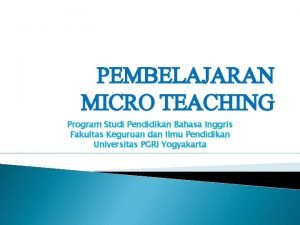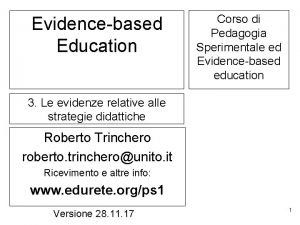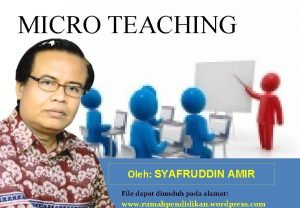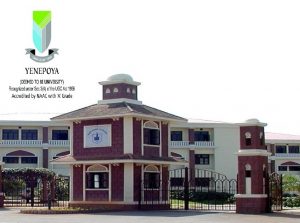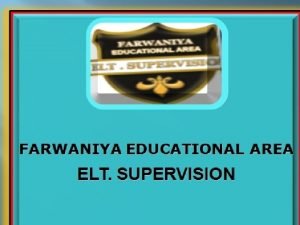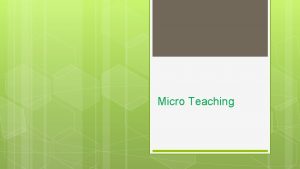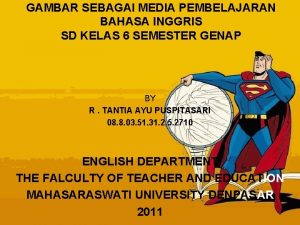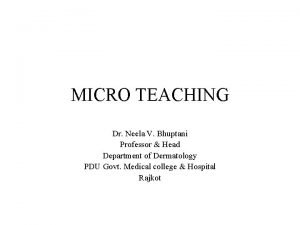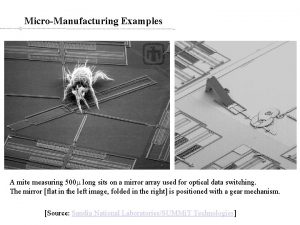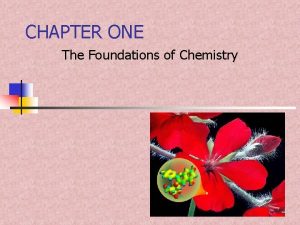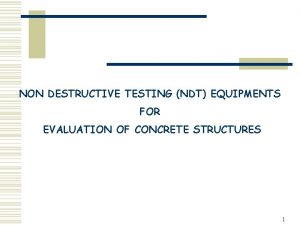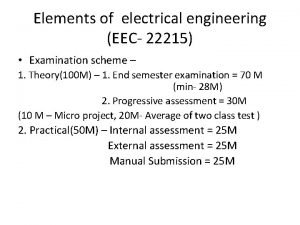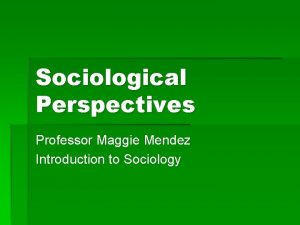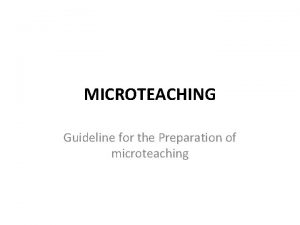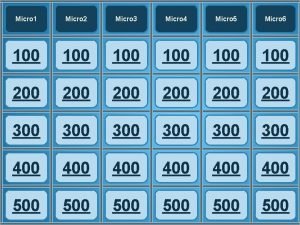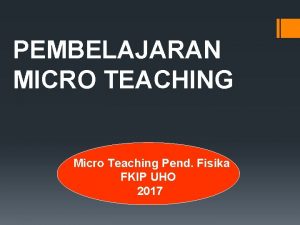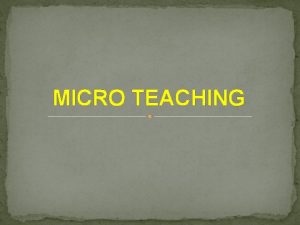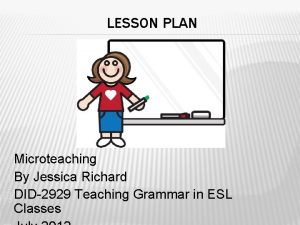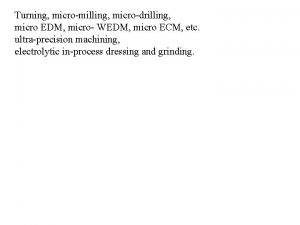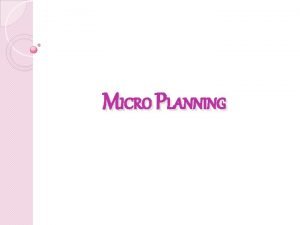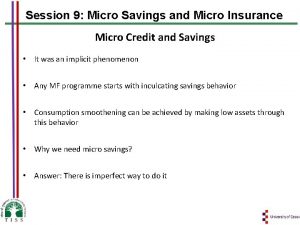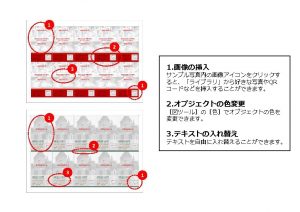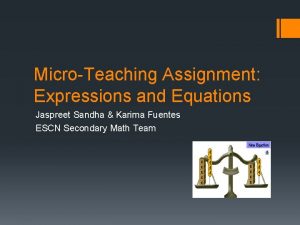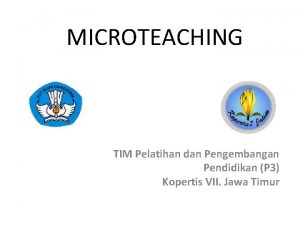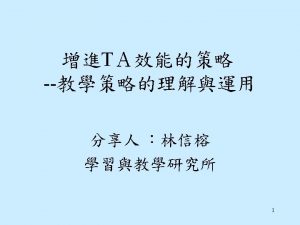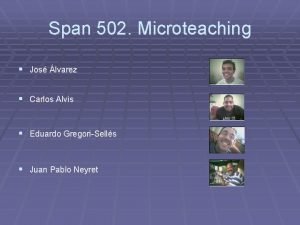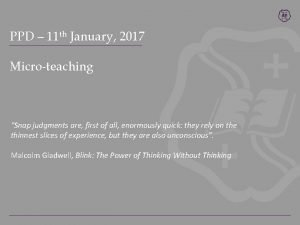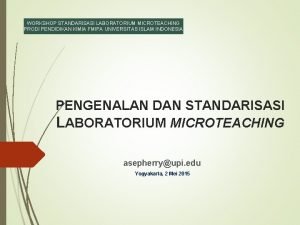Micro Teaching What is micro teaching Microteaching is




























- Slides: 28

Micro Teaching

What is micro teaching? Micro-teaching is a training system designed to improve teaching skills of teacher/instructor trainees. It is a scaled down (micro) version of actual teaching in which a teacher/instructor trainee teaches a group of colleagues for a time less than the normal lesson time allocated in an actual teaching situation.

How Microteaching Works? Microteaching sessions involve one student teacher, the class instructor (or school supervisor), and a small group of peers. These sessions allow student teachers to practice and polish their teaching techniques in a simulated environment before putting them into practice with students. Using the teaching method, which was revised and simplified in the late 1980 s and early 1990 s, student teachers conduct a short lesson (usually 5 -20 minutes in length). Microteaching sessions focus on one teaching skill at a time. This singular focus provides the opportunity for student teachers to master each technique by planning and teaching the same lesson multiple times, making adjustments based on peer and instructor feedback.

What is the aim of micro teaching? The aim of micro-teaching is to give the trainee instructor an opportunity to prepare and present lessons (both theory or demonstration) in order to apply the skills taught and learned. On completing the micro-teaching, the trainee-instructor will be able to: Prepare and apply lesson plans effectively during lesson presentation Apply the skills taught Demonstrate and practice a variety of teaching techniques

Key factors of micro teaching Micro-teaching is based on theory that teaching consists of a number of basic factors or skills such as: Communication Explaining Organizing Questioning techniques Motivation of learners Problem solving decision making Each of these factors can be improved upon by analysis and practice in much the same way athletes carry out their training. During micro-teaching the skills acquired by instructor-trainees are practiced during lesson presentation.

Underlying Principles of Micro teaching: Microteaching revolves around certain principles to improve its reach in the allround development of the teachers. 1. One skill at one time: Skills in microteaching are targeted one at a time. Training on particular skills are given until it is mastered. Once mastered another skill is targeted next. Thus, micro teaching aims for one skill at a time. 2. Small scale content: Limiting the content gives more freedom and ease to the trainees. Thus, micro teaching is based upon the principle of limited content. Teachers are to prepare their lessons within the given content, therefore, it becomes easier for them to conduct their lessons. 3. Practice makes a man perfect: Mastering skills require practice. While focusing on one skill at a time, micro teaching program also gives an opportunity to practice those skills. Lots of practice can boost the self-confidence and promote in development of teaching skills.

Underlying Principles of Micro teaching: (cont’d) 4. Experiments: Experiments are the key factors in any concept. In micro teaching, many experiments are conducted in order to test the skills of the teachers. For example, the supervisors conduct experiments where the length of the lessons, time duration, the strength of students in the class etc is changed. These skills are tested under controlled condition. 5. Instantaneous feedbacks: Micro teaching consists of teacher-pupil and supervisor as students. Once a session ends, teacher-pupil and supervisors come up with their feedback. This feedback is given instantly after the lesson plan ends. Thus, it helps in rectifying the drawbacks. 6. Self-evaluation opportunities: Evaluation plays an important role in any task. In micro teaching, supervisors conduct various tests and thus there are several chances to analyse mistakes. Evaluation gives an opportunity to understand the mistake and overcome it. This program includes a session where drawbacks are pointed out along with their solution. Thus, overall improvement becomes an easier target.

Underlying Principles of Micro teaching: (cont’d) 7. Continuous efforts: Acquiring and mastering skills is a slow and ongoing process. Even after mastering a previous skill, one should continually strive for betterment. Continuous efforts make it easier to attain overall development.

Concept of Micro teaching: Micro-Teaching is a special teaching practice model or teaching training method. In this teaching context, there contains many actions like use of methods, usage of media, learning guide, motivation, classroom management, assessment, analysing and so on.

Concept of Micro teaching: (cont’d) The concept of microteaching is mainly based on the following points; ü ü ü ü Teaching in its real form but with a minimum concept The exercise which is designed focuses mostly on the basic teaching skills with the help of feedback based on the knowledge and information of student learning level. The teaching is conducted for students who are from different backgrounds and their intellectual abilities. Monitoring the micro teaching exercises conducted in classrooms Enabling the prospective teachers to learn effective teaching skills. Helping the students to actively participate in teaching by providing a low-risk situation. It also offers opportunities for retraining at regular time intervals

Preparation for Micro-teaching preparation needs to proceed systematically in a step-by-step fashion. Step 1: The instructor trainee prepares a small lesson often in the light of previous lectures, discussions etc. to do with some aspects of learning and teaching. Step 2: A few specific skills are concentrated on e. g. questioning techniques, explaining (exposition) etc. during the lesson. STEP 3: Class size (consisting of fellow trainee instructors) should be between 5 and 10 at most. This number is far below the group of 20 to 35 trainees found in a normal class. STEP 4: The time limit is by far less than the normal 30 to 40 minutes in a regular lesson. This would take between 7 and 12 minutes. STEP 5: The instructor trainee teaches what s/he has prepared to a group of colleagues. STEP 6: Feedback session. After the trainee has taught the lesson, s/he is given a feedback. Feedback is given by his/her colleagues as well as the trainer. The feedback should be balanced and should focus on both the positive aspects as well as the perceived weakness. It is done with a view to improving rather than destroying the morale of the teacher-trainee. STEP 7: Deciding to re-teach the lesson. In the light of the feedback and the overall critique, the teacher-trainee prepares to re-teach the lesson. S/he re-plans the lesson and gets another opportunity to teach a group similar to the first one taught. After every stage of the micro-teaching performance is reviewed and discussed, focusing attention on only one or two teaching skills, such as questioning techniques, motivation of class, class control etc. at a time.

Procedure of Micro teaching: 1. Skill definition: The pupil-teacher or the supervisor defines a certain skill. The skills of micro teaching are defined regarding the teaching behaviours in order to procure knowledge of required skills, which they have to focus on.

Procedure of Micro teaching: (cont’d) 2. Demonstration: The demonstration is the second step in the process. Experts demonstrate the specific skill by themselves or with the help of audiovideo tape recordings to the teacher trainee. This gives an idea to the teachers to work accordingly.

Procedure of Micro teaching: (cont’d) 3. Lesson planning: This step is the first action by the student teacher. The trainee teacher plans a short lesson through which he/she could practice the skill. This microteaching lesson plan is done with the help of his supervisor.

Procedure of Micro teaching: (cont’d) 4. Conducting lesson: Once the planning is done, according to the targeted skill the pupil-teacher teaches the planned lesson to the group of students. These lessons are observed by supervisor and pupil teachers. Further, they are videotaped, audio -taped, or televised through a CCTV camera. These tapes are later used for self-evaluation as well.

Procedure of Micro teaching: (cont’d) 5. Discussion and conclusion: Once the teaching session comes to an end it is followed by a concluding session. Concluding session consist of feedback by the supervisor. During this session, the audio or video recording may also be displayed in order to give an opportunity to evaluate oneself. Moreover, it also boosts the confidence level of the trainee. It is the best way to reinforce the trainee to work better the next time.

Procedure of Micro teaching: (cont’d) 6. Re-planning: Mastering a skill is an ongoing process. Thus, once the cycle of micro teaching revolves, the process is repeated. This repetition involves the replanning of the lesson plan. The aim of this re-planning is to master the skill mentioned earlier.

Procedure of Micro teaching: (cont’d) 7. Re-teaching: On completion of the replanning of the lesson, it is again taught to another group of students from the same class. The time duration is kept as same as the previous class. This method contributes in practising the skill repeatedly.

Procedure of Micro teaching: (cont’d) 8. Re-discussion: At the end of the re-teaching session, the discussion and conclusion step is repeated. These discussions and suggestions encourage the performance of the trainee. Thus, the process of feedback is procured to enhance performance furthermore.

Procedure of Micro teaching: (cont’d) 9. Redoing: After the end of every session, this cycle is repeated. The repetition is continued until the required skill is mastered. This process is repeated while attaining all the required skills.

Three Phases of Microteaching: 1. Knowledge acquisition: This is the first phase of micro teaching. It includes the collection of data. In this phase, the trainee teacher gathers knowledge about the required skills by reading different literature as well as going through certain demonstrating videos. Further, this phase includes the understanding of required skill in a rational manner, as a classroom component.

2. Skill acquisition: This is the working phase of the micro teaching program. Under this phase, the trainee teacher is asked to prepare lessons and practice skills based on the model presented at the start. Here, the two important factors of micro teaching are the feedback and the setting. Setting includes the length of the lesson, the duration of the class, the skill to be obtained, the supervisor and the students.

3. Transferring phase: This is the last and major phase of micro-teaching. Here the trainee comes out in a real situation, which is not controlled. Here the teachers, as well as the students, get the platform to learn and grow. This takes place in a real classroom, unlike the previous stages of micro teaching.

Benefits of Microteaching Enables separate skills to be practiced and perfected· Provides an opportunity for immediate feedback and further practice. Provides a less threatening class environment, and hence no big problem of class control. Constructive criticisms are made by peers and the trainer in a friendly atmosphere. There is room for practicing the skills and making improvement.

Disadvantages of Microteaching is considered one of the most effective techniques for teacher training, but it does have a few drawbacks. Most significantly, microteaching requires the presence of an instructor and a group of peers, which means that not all student teachers (or current teachers) can consistently complete microteaching sessions. Ideally, microteaching sessions are repeated multiple times so that the student teacher can refine his or her skills. However, in larger education programs, there may not be time for all student teachers to complete multiple sessions.

Disadvantages of Microteaching is considered one of the most effective techniques for teacher training, but it does have a few drawbacks. Most significantly, microteaching requires the presence of an instructor and a group of peers, which means that not all student teachers (or current teachers) can consistently complete microteaching sessions. Ideally, microteaching sessions are repeated multiple times so that the student teacher can refine his or her skills. However, in larger education programs, there may not be time for all student teachers to complete multiple sessions.


 Microteaching definition
Microteaching definition Blackboard skill components
Blackboard skill components Microteaching bahasa inggris
Microteaching bahasa inggris Un carpentiere ha 32 metri di tavole soluzione
Un carpentiere ha 32 metri di tavole soluzione Microteaching adalah
Microteaching adalah Micro teaching in india
Micro teaching in india Advantages of micro teaching
Advantages of micro teaching Microteaching
Microteaching Micro teaching skills
Micro teaching skills Format of micro teaching lesson plan
Format of micro teaching lesson plan Micro teaching cycle
Micro teaching cycle Gambar pelajaran bahasa inggris
Gambar pelajaran bahasa inggris Advantage of micro teaching
Advantage of micro teaching 2010 micro frq
2010 micro frq Micro focus adjustment
Micro focus adjustment Micro manufacturing examples
Micro manufacturing examples Milli chemistry
Milli chemistry Probe penetration test concrete
Probe penetration test concrete Micro engineering solutions
Micro engineering solutions Micropot
Micropot Micro konverzió
Micro konverzió Attawfiq
Attawfiq Micro hotplate
Micro hotplate Eec micro project
Eec micro project Micro inequities in the workplace
Micro inequities in the workplace Company background of kfc
Company background of kfc Micro sociological perspective
Micro sociological perspective Factores macro y microambientales de la mercadotecnia
Factores macro y microambientales de la mercadotecnia Micro data center rhône alpes
Micro data center rhône alpes


